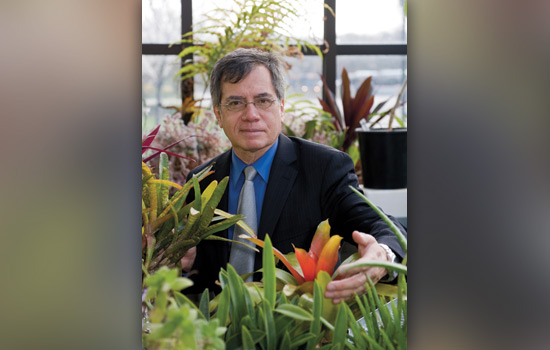Hector Flores
A. Sue Weisler
Hector Flores in the Thomas H. Gosnell School of Life Sciences greenhouse.
Hector Flores became dean of graduate studies last September. He had previously been dean of science at Texas State University and worked in faculty and administrative roles at Louisiana State University, Pennsylvania State University and Arkansas State University. Flores, who was born in Lima, Peru, is internationally recognized for his work in plant biology but has a love of literature and music. (He has a collection of about 6,000 books and worked as a jazz disc jockey throughout his career.) Here are his thoughts on his science and liberal arts background, along with his plans for graduate studies at RIT. There are nearly 3,000 graduate students in more than 70 programs at the master’s and doctoral levels.
I always tell people that the reason I am here is the decision my parents made to put me in a Catholic bilingual school for 11 years. I got what I always call my liberal arts education in high school because my teachers had me reading Macbeth and Pablo Neruda when I was 12 years old. That stayed with me.
My father was also a very good mandolin player. He took me to my first classical music concert when I was 6 and I still remember the first movement of Beethoven’s Pastoral Symphony and I compare every version I hear to that one. Even though I studied a very traditional science curriculum in college, I had that liberal arts upbringing and it really has impacted everything I have done since.
Why biology? It’s probably the microscope I got when I was 7 or 8 years old. A lot of things happen through early imprinting. Some are good, some are bad, but in this case most of them were good.
I went to Puerto Rico for a fellowship and I decided to stay there for my master’s. When I was in the middle of my master’s studies in horticulture, a group of recruiters from Yale came to the campus. I got enamored with the idea of going to Yale for graduate school and applied but did not get admitted. So I went to Rutgers, where I was offered a graduate research assistantship. But I didn’t give up on the idea of going to Yale, and that winter I took the train to New Haven and I met professor Arthur W. Galston, who eventually became my advisor and mentor. I got admitted the following fall. I don’t give up easily.
Ten years ago I was a finalist for the dean of science position (at RIT). The internal candidate was selected for the position and at that time I had little administrative experience. But I knew the place at least a little bit from that campus visit and decided to give it another try.
This place is very special. I think there’s such an amazing potential to bring together the technical disciplines, the engineering disciplines and the science disciplines with the arts and the humanities. In a way this fits my upbringing because I can relate to that. I have never been adverse to try to integrate social sciences and art sciences into what I do. In fact, I thrive on doing that.
One of the things I’m trying to achieve is if we can, at least experimentally, bring students from widely different disciplines into new types of graduate courses. Instead of doing problem solving within engineering or problem solving within imaging science, I’d like to create intellectual and innovation spaces where you can do interdisciplinary problem solving. For example, you can bring together an arts student with a sustainability student and an engineer and see what they come up with.
My challenge, which is also my luxury, is that I don’t have a lot of resources so we need to create our own case for how graduate studies can help. The only way you can do this is by networking with administrators, students and faculty. Along the way, you discover things that the deans and the conventional colleges usually do not discover because they have to focus on their own faculty. This creates a different way in which you interact and the exchange becomes really intellectual and sets the basis for innovation at the graduate level.















